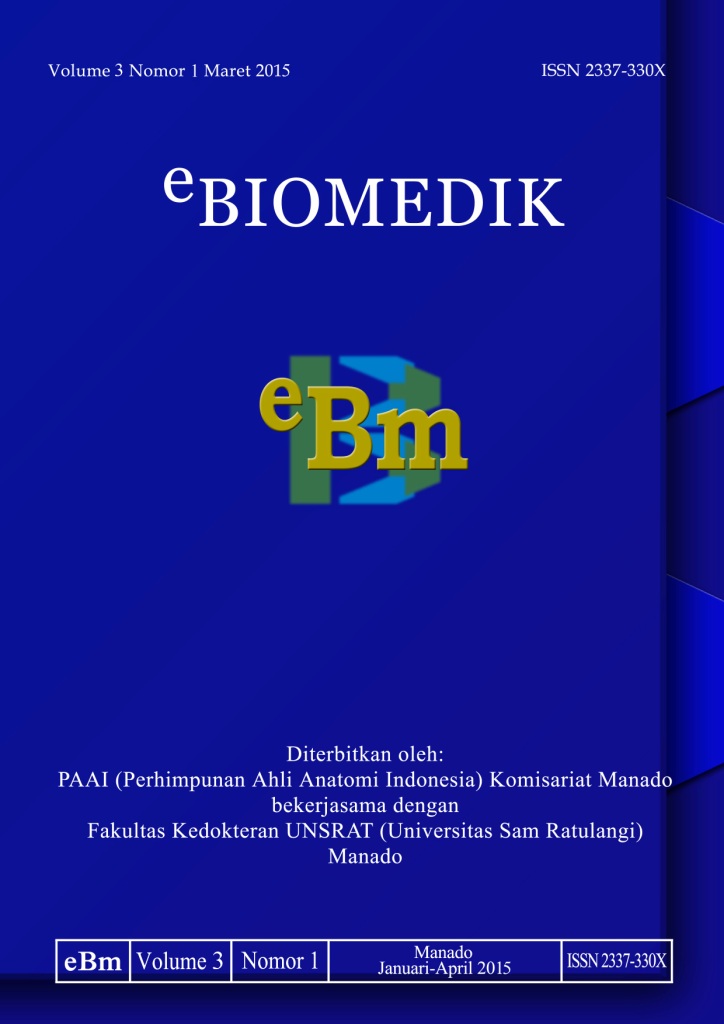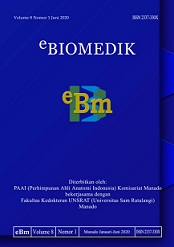POLA BAKTERI YANG BERPOTENSI MENJADI SUMBER PENULARAN INFEKSI NOSOKOMIAL DI IRINA C RUANGAN INTERMEDIATE CARE (IMC) BLU RSUP PROF. DR. R. D. KANDOU MANADO
DOI:
https://doi.org/10.35790/ebm.v3i1.6636Abstract
Abstract: The hospital is a place to care for patients with various diseases such as infectious diseases, ranging from mild to severe. It can cause the infection spread from one patient to another, as well as with health care workers who are often exposed to infectious agents. Hospitalized patients at very high risk for nosocomial infection, caused by the condition of their disease, and the risk is compounded when patients undergoing invasive procedures. This is caused non-pathogenic microorganisms capable of causing disease. Research or clinical testing in the laboratory necessary to determine whether the treatment in IMC has the potential to become source of nosocomial infection transmission. The purpose of this study was to determine the source and microorganisms that could potentially lead to the transmission of nosocomial infections in IRINA C Intermediate Care (IMC) BLU Dr Prof. Dr R. D. Kandou. This study is a prospective descriptive study. The samples are floor and wall of treatment rooms, indoor furniture, medical equipment and air in IRINA C Intermediate Care (IMC) BLU Dr Prof. Dr RD Kandou Manado. There are 30 samples and swabs taken. Identification of bacteria were performed with culture medium. In this study, Bacillus subtilis found in 10 samples (33.4%), Enterobacter agglomerans in 4 samples (13.4%), Staphylococcus in 4 samples (13.4%), Klebsiella pneumonia in 3 samples (10%), Coccus grams negative in 2 samples (6.7%), Candida in 2 samples (6.7%), Morganella Morganii in 1 sample (3.4%), Enterobacter aerogenes in 2 samples (6.7%), Streptococcus in 1 sample (3.4%), and Salmonella in 1 sample (3.4%). This research concluded that Bacillus subtilis is the most found bacteria .
Keywords: Nosocomial infection, IMC, bacteria.
Abstrak: Rumah sakit merupakan tempat pelayanan pasien dengan berbagai macam penyakit yang diantaranya penyakit karena infeksi, mulai dari ringan sampai berat. Hal ini dapat menyebabkan resiko penyebaran infeksi dari satu pasien ke pasien lainnya, begitupun dengan petugas kesehatan yang sering terpapar dengan agen infeksi. Pasien rawat inap beresiko sangat tinggi untuk terjadinya infeksi nosokomial, ini disebabkan karena kondisi penyakit mereka, dan risiko diperparah ketika pasien menjalani prosedur invasif. Hal ini menyebabkan mikroorganisme yang biasanya tidak patogen mampu menyebabkan penyakit. Diperlukan penelitian atau pengujian secara klinis di laboratorium untuk mengetahui apakah di ruang perawatan IMC mempunyai potensi sumber penularan infeksi nosokomial. Tujuan dari penelitian ini adalah untuk mengetahui sumber dan mikroorganisme yang berpotensi menyebabkan penularan infeksi nosokomial di IRINA C Intermediate Care (IMC) BLU RSUP Prof. Dr. R. D. Kandou. Penelitian ini menggunakan metode penelitian deskriptif prospektif. Sampel yang diteliti adalah lantai dan dinding ruangan perawatan, perabotan ruangan, peralatan medis dan udara di IRINA C Intermediate Care (IMC) BLU RSUP Prof. Dr. R. D. Kandou Manado sebanyak 30 sampel dan diambil secara usapan. Identifikasi bakteri dilakukan dengan media kultur. Pada hasil penelitian menunjukan Bacillus subtilis 10 sampel (33,4%), Enterobacter agglomerans sebanyak 4 sampel (13,4%), Staphylococcus sebanyak 4 sampel (13,4%), Klebsiella Pneumonia sebanyak 3 sampel (10%), Coccus gram negatif sebanyak 2 sampel (6,7%), Kandida sebanyak 2 sampel (6,7%), Morganella Morganii sebanyak 1 sampel (3,4%), Enterobacter aerogenes sebanyak 2 sampel (6,7%), Streptococcus sebanyak 1 sampel ( 3,4%), dan Salmonella sebanyak 1 sampel (3,4%). Kesimpulan pada penelitian ini jenis bakteri terbanyak ditemukan adalah Bacillus subtilis.
Kata kunci: Infeksi nosokomial, IMC, bakteri.





